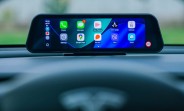Tesla releases new Full Self Driving beta software with a lot of improvements

Today Tesla has released the latest version of its Full Self Driving (FSD) beta software to those cars which are enrolled in the testing program. Currently there are around 100,000 owners that are actively testing Tesla's FSD software, and the newest release comes with a bunch of improvements left and right.
Tesla says the update is based on over 250,000 training clips from its fleet's movements, and it's the first time the company has made such a number public. The new FSD beta software is build 2022.12.3.10, and it's one of the most extensive updates to date.

There are several improvements related to the level of confidence at which the system takes action, and three older neural nets have been removed from the system, which Tesla says enables a 1.8 fps improvement in the system frame rate.
Despite what its name might imply, FSD is still considered a Level 2 driver assistance system, because the driver needs to remain vigilant and ready to take control at all times. A Level 3 system would require none of that, but so far that's pretty much remained a pipe dream.
Here is the full changelog:
• Upgraded decision making framework for unprotected left turns with better modeling of objects’ response to ego’s actions by adding more features that shape the go/no-go decision. This increases robustness to noisy measurements while being more sticky to decisions within a safety margin. The framework also leverages median safe regions when necessary to maneuver across large turns and accelerating harder through maneuvers when required to safely exit the intersection.
• Improved creeping for visibility using more accurate lane geometry and higher resolution occlusion detection.
• Reduced instances of attempting uncomfortable turns through better integration with object future predictions during lane selection.
• Upgraded planner to rely less on lanes to enable maneuvering smoothly out of restricted space.
• Increased safety of turns crossing traffic by improving the architecture of the lanes neural network which greatly boosted recall and geometric accuracy of crossing lanes.
• Improved the recall and geometric accuracy of all lane productions by adding 180,000 video clips to the training set.
• Reduced traffic control related false slowdowns through better integration with lane structure and improved behavior with respect to yellow lights.
• Improved the geometric accuracy of road edge and line predictions by adding a mixing/coupling layer with the generalized static obstacle network.
• Improved geometric accuracy and understanding of visibility by retraining the generalized static obstacle network with improved data from the auto labeler and by adding 30,000 more video clips.
• Improved recall of motorcycles, reduced velocity error of close-by pedestrian and bicyclists, and reduced heading error of pedestrians by adding new sim and auto-labeled data to the training set.
• Improved precision of the “is parked” attribute on vehicles by adding 41,000 clips to the training set. Solved 48% of failure cases captured by our telemetry of 10.11.
• Improved detection recall of faraway crossing objects by regenerating the dataset with improved versions of the neural networks used in the auto labeler, which increased data quality.
• Improved offsetting behavior when maneuvering around cars with open doors.
• Improved angular velocity and lane-centric velocity for non-VRU objects by upgrading it into network predicted tasks.
• Improved comfort when lane changing behind vehicles with harsh deceleration by tighter integration between lead vehicles future motion estimate and planned lane change profile.
• Increased reliance on network-predicted acceleration for all moving objects, previously only longitudinally relevant objects.
• Updated nearby vehicle assets with visualization indicating when a vehicle has a door open.
• Improved system frame rate +1.8 frames per second by removing three legacy neural networks.
Reader comments
- CptPower
- SH3
Looks interesting and promising. But no matter how great AI will be it will never surpases skill of the humans.
- Self driving guy
- g5f
You need "stupid" AI to act like dog of car, holding SW glitches together. Don't see other way, maybe trust your dog riding your car with neuralink? There are ways.





Facebook
Twitter
Instagram
RSS
Settings
Log in I forgot my password Sign up